#2thessalonians2
Text
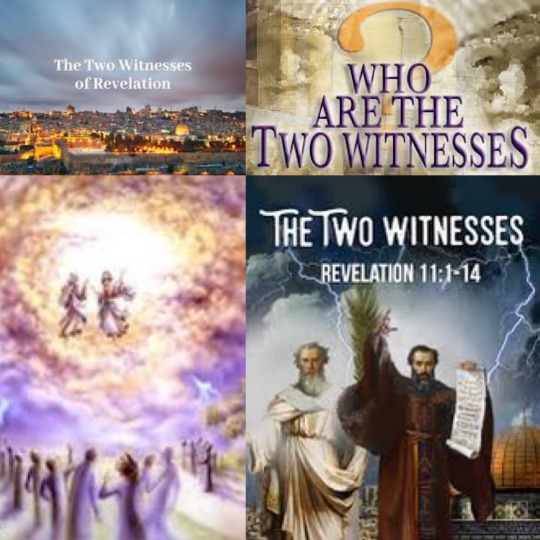
The Two Witnesses of Revelation 11
Eli Kittim
The Two Witnesses are Anointed with Power
In Rev. 11:4, the two witnesses on earth are said to be “the two olive trees” of the Lord. This verse is based on the Old Testament:
“These are the two anointed ones who stand
by the Lord of the whole earth.”
— Zechariah 4:14
The term “Messiah” (Gk. Christos) is derived from the Hebrew word mashiach, which means “anointed one.” So, Zechariah 4:14 cannot be talking about anyone else except the Messiah. As I will demonstrate, these two anointed witnesses could be none other than Jesus Christ and the Holy Spirit. And these two are one! The Holy Spirit is often called the “Spirit of Jesus Christ” (Phil. 1:19), the “Spirit of Jesus” (Acts 16:7), or “the Spirit of His Son” (Gal. 4:6). We know that the Messiah is the “anointed one” (Dan. 9:26). But the Holy Spirit is “anointed” as well (1 Jn 2:20, 27), and anoints Jesus with power (see Lk 4:18; Acts 10:38). The anointing takes place when Jesus and the Holy Spirit become one (during Jesus’ baptism)! It is Jesus’ rebirth, so to speak, when the Holy Spirit enters him and anoints him with power (Lk 3:22; cf. Acts 2:1-4)!
As for those thinkers who take issue with this view, claiming that the two witnesses are probably Enoch and Elijah who never died, there are three problems with their theory. First, regardless of whether a biblical character died or not, scripture makes it clear that you only live once (Heb. 9:27); there is no reincarnation. A reincarnation of Enoch or Elijah is therefore out of the question. Second, neither Enoch nor Elijah were the anointed Messiah. Third, both of these fictional characters are “types” who represent and foreshadow the Messiah. Notice the specific typology that is presented in Revelation 11 which typifies the two witnesses’ unique relation and connection to Jesus: the two witnesses are said to prophesy in the exact same place where Jesus supposedly lived, and they will die in the exact same city where Jesus allegedly died. I think you can guess the rest of the script: “But after … three … days a breath of life from God entered them, and they stood up on their feet” (Rev. 11:11). Just like Jesus, they’ll be miraculously raised from the dead after 3 days!
Moreover, Rev. 11:6 says that the two witnesses have tremendous authority (ἐξουσίαν) over heaven and earth to do as they please. However, only Jesus has that kind of authority. No one else! Jesus says: “All authority in heaven and on earth has been given to me” (Mt. 28:18):
Ἐδόθη μοι πᾶσα ἐξουσία ἐν οὐρανῷ καὶ ἐπὶ
τῆς γῆς ·
Both Jesus and the Holy Spirit are called Witnesses
What is more, the two witnesses’ assignment is to bear witness to the truth (μαρτυρίαν; Rev. 11:7). The two persons of the Godhead who bear witness (μαρτυρήσει) to the truth on earth are Jesus and the Holy Spirit (see Jn 15:26; 18:37; Rom. 8:16; Heb. 10:15 [Μαρτυρεῖ/bears witness]). Case in point. First John 5:6 mentions the witness of the Spirit——namely, that God comes in the flesh——using the symbols of “water and blood” which represent the divinity and humanity of Jesus, thus indicating that he’s both God and man:
“This man, Jesus the Messiah, is the one
who came by water and blood—not with
water only, but with water and with blood.
The Spirit is the one who verifies this,
because the Spirit is the truth.”
Then, 1 John 5:7-8 goes on to explain that “these three [witnesses] are one”:
“For there are three witnesses
[μαρτυροῦντες] — the Spirit, the water, and
the blood—and these three are one.”
— 1 John 5:7-8
And 1 Jn 5:9 tells us that the content of this prophetic witness (ἡ μαρτυρία τοῦ θεοῦ) concerns the coming of the Son of God in human form at some point in human history. The Greek verb ἐλθὼν (came) is not referring to the time of action, but rather to the Christological prophecy which is supposed to take place according to the scriptures (cf. 1 Cor. 15:3-4). So the testimony of the two witnesses of Revelation 11 is about the parousia, or the coming of Jesus to this earth! Interestingly enough, Rev. 1:5 calls Jesus “the faithful witness” (ὁ μάρτυς, ὁ πιστός). This is reiterated in Rev. 3:14 where Jesus is “the faithful and true witness.” Both Jesus and the Holy Spirit are said to be God’s two witnesses, and these two are one! Since no one else except God can do these extraordinary miracles (e.g. fire-breathing, controlling the weather & the sea [cf. Mk 4:39], causing plagues; Rev. 11:5-6), and given that the language of the Greek New Testament is pointing to the authority, anointing, and witness of Jesus and the Holy Spirit, there can be little doubt as to who these two witnesses are.
First Comes Christ; Then Comes the Antichrist
The sequence of end-time events also reveals New Testament parallels and verbal agreements that are consistent with the notion that the Messiah will come first, followed by the antichrist. Notice the same sequence in Rev. 11:7:
“And when they have finished their witness,
the beast that comes up out of the abyss
will make war with them and overcome
them and kill them.”
This is essentially the same sequence that we find in 2 Thess. 2. The restrainer must first be taken out of the way before the lawless one can be revealed (2 Thess. 2:7-8). In other words, the restrainer must be removed before the antichrist can appear on the world stage. This same motif is repeated in Rev. 12:3-4 (italics mine):
“a great red dragon, with seven heads and
ten horns [representing the Antichrist and
the final world empire] … stood before the
woman who was about to give birth, so that
when she bore her child he might devour it.”
The way Rev. 12:5 is described, it’s as if it gives us Jesus’ birth, resurrection, and ascension, minus his death (which is alluded to in verse 4):
“She gave birth to a male child, one who is to
rule all the nations with a rod of iron, but her
child was caught up to God and to his
throne.”
So, in Rev. 12, the male child is born first, and then the red dragon kills it. It’s the exact same sequence in Rev. 6. First comes the peaceful white horseman “holding a bow” (representing the covenant; see Gen. 9:13 LXX) and wearing the Stephanos crown, which is typically worn by victors in Christ (Jas. 1:12; 2 Tim. 4:8; 1 Pet. 5:4; Rev. 2:10; 4:4), and then comes the red horse which triggers World War III (Rev. 6:3). We find the exact same sequence in Rev. 11:7. First come the two witnesses, and then comes the beast out of the abyss to kill them. This is the antichrist who must come after Christ. It’s the exact same motif in 2 Thess. 2:7-8 in which the restrainer must be killed before the antichrist can appear.
So, there’s a running theme throughout the New Testament which repeats the same end-time sequence in all these narratives, namely, the idea that Christ comes first, followed by the Antichrist! Thus, Christ’s coming is imminent (it can happen at any time)! But how is all this possible if Christ already died two thousand years ago? It’s possible because the gospels are not historical documents that correspond to real historical events. They’re theological narratives that are largely based on the Old Testament. By contrast, the epistles, which are the more explicit and didactic portions of scripture, say that Christ will die “once for all” (Gk. ἅπαξ hapax) “at the end of the age” (Heb. 9:26b), a phrase which consistently refers to the end of the world (cf. Mt. 13:39-40, 49; 24:3; 28:20). Similarly, just as Heb. 1:2 says that the physical Son speaks to humanity in the “last days,” 1 Pet. 1:20 (NJB) demonstrates the eschatological timing of Christ’s *initial* appearance by saying that he will be “revealed at the final point of time.” In other words, Revelation 6:2, 11:3, 12:5, and 19:11 all refer to the first coming of Jesus at the end of days!
#two witnesses#Revelation11#Zechariah4v14#anointed#messiah#holy spirit#endtimes#thefaithfulwitness#jesus christ#the little book of revelation#ἐξουσίαν#typology#rebirth#the_first_coming_of_Jesus_at_the_end_of_days#Elikittim#bible prophecy#lastdays#waterandblood#τομικροβιβλιοτηςαποκαλυψης#baptism#thejesusprophecy#the_future_incarnation_of_Christ#reincarnation#μαρτυρίαν#Revelation12v5#ελικιτίμ#Revelation11v3#2Thessalonians2#Revelation6v2#Revelation19v11
4 notes
·
View notes
Text
Revelation 20: Satan's Last Stand
What do Ezekiel and Paul have to add to John's oracle about Satan and the Lake of Fire?
#Revelation20 #LakeofFire #Ezekiel38 2Thessalonians2 #GogandMagog
Then, when the thousand years shall come to an end, the Adversary [Satan] will be released out of his prison, and he will go forth to lead astray the nations that are in the four corners of the earth, Gog and Magog, to gather them before the battle, of whom the number of them is as the sand of the sea.
Then they went up over the breadth of the earth and encircled the encampment of the holy and…

View On WordPress
#2 Peter 3#2 Peter 3:7-10#2 thessalonians 1#2 Thessalonians 2#eternal torment#ezekiel 38#ezekiel 39#fire from heaven#gog#gog and magog#lake of fire#Magog#Millennium#REvelation 20#Revelation 20:7-10#thousand year reign
0 notes
Text
Do not let anyone ·fool [deceive] you in any way. That day of the Lord [v. 2] will not come until the ·turning away from God [great rebellion; apostasy; Matt. 24:11–12; 1 Tim. 4:1; 2 Tim. 3:1–5; 2 Pet. 2:3; Jude 18] happens and the Man of ·Evil [Wickedness; L Lawlessness; C probably the Antichrist; 1 John 2:18; Rev. 13], ·who is on his way to hell [L the son of destruction; John 17:12] , appears.He will ·be against [defy; oppose] and ·put himself above [exalt himself against] any so-called god or ·anything that [any object that; or any place where] people worship [Is. 14:13–14; Ezek. 28:2–9; Dan. 11:36] ·and [or so that] he will even go into the Temple of God and sit there and ·say that he is [present himself as] God. - 2 Thessalonians 2:3-4 http://www.biblegateway.com/passage/?search=2Thessalonians2:3-4&version=EXB
0 notes
Photo
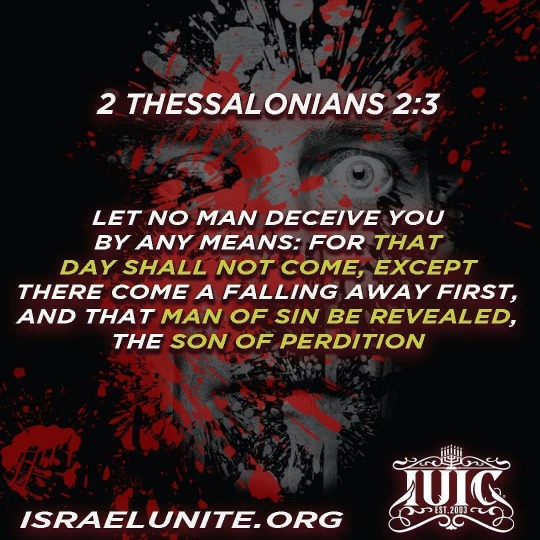
#2Thessalonians2:3 Let no man deceive you by any means: for that day shall not come, except there come a falling away first, and that man of sin be revealed, the son of perdition; #DailyBread #BibleVisuals #BibleImagery #IUIC #Esau #Scriptures https://www.instagram.com/p/CF7XT7nnX_f/?igshid=4j671zpf2f8r
2 notes
·
View notes
Photo

#2thessalonians2 https://www.instagram.com/p/CH9b9jTHTg6/?igshid=qr9ortvjx7ca
0 notes
Photo
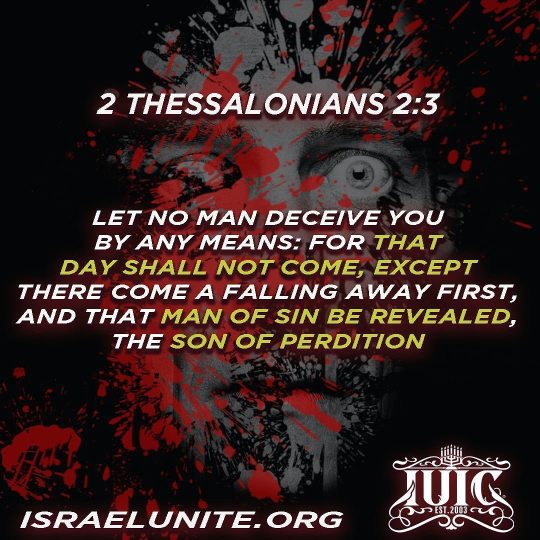
#2Thessalonians2:3 Let no man deceive you by any means: for that day shall not come, except there come a falling away first, and that man of sin be revealed, the son of perdition; #DailyBread #BibleVisuals #BibleImagery #IUIC #Esau #Scriptures https://www.instagram.com/p/CF9g0-rHEDu/?igshid=1kqng47e4p6hy
0 notes
Photo
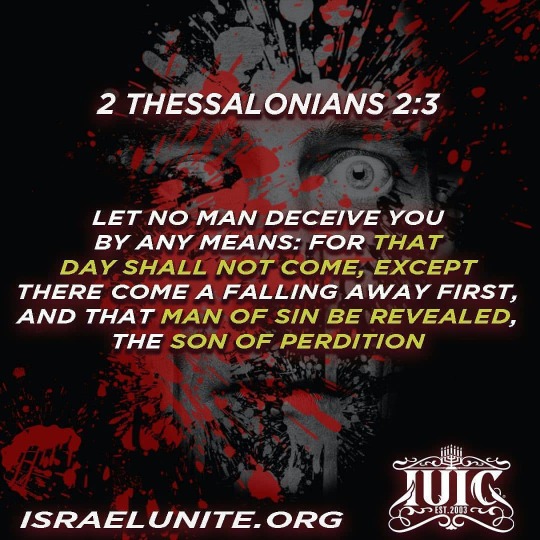
#2Thessalonians2:3 Let no man deceive you by any means: for that day shall not come, except there come a falling away first, and that man of sin be revealed, the son of perdition; #DailyBread #BibleVisuals #BibleImagery #IUIC #Esau #Scriptures #2 Thessaloniciens 2:3 Que personne ne vous séduise en aucune manière; car il faut que la révolte soit arrivée auparavant, et qu'on ait vu paraître l'homme du péché, le fils de la perdition, #PainQuotidien #visuelsbibliques #ImageBibliques #IUIC #Esaü #Écritures https://www.instagram.com/p/CF7k2shn6rS/?igshid=5ukojw719um9
#2thessalonians2#dailybread#biblevisuals#bibleimagery#iuic#esau#scriptures#2#painquotidien#visuelsbibliques#imagebibliques#esaü#écritures
0 notes
Photo

2 கொரிந்தியர் 9 15: தேவன் அருளிய சொல்லிமுடியாத ஈவுக்காக அவருக்கு ஸ்தோத்திரம். Thanks be unto God for his unspeakable gift. (KJV) Thank you Jesus 🙏 🌿🌺🌿🌲🌷🌿🌲🌺🌲🌿🌲🌿🌷🌲🌿🌺🌿🌲🌿🌷🌿🌲🌿🌲🌿🌿🌿🌷 #dailyencouragement #dailyquotes #inspiration #scriptures #Christ #Isaiah56 #2Thessalonians2 #John8 #honour #instruct #corrects #truth #bitter #sweet #wisdom #justice #mercy #power #compassion #Lord #HolySpirit #faith #prayer #light #getup #bless #darkness #imsorry #beauty #manofgod (at கோவில்பட்டி) https://www.instagram.com/p/B3yHz-jgtV8/?igshid=1eafzbp6xwukd
#dailyencouragement#dailyquotes#inspiration#scriptures#christ#isaiah56#2thessalonians2#john8#honour#instruct#corrects#truth#bitter#sweet#wisdom#justice#mercy#power#compassion#lord#holyspirit#faith#prayer#light#getup#bless#darkness#imsorry#beauty#manofgod
0 notes
Photo

Love!! #sunday #2thessalonians #2thessalonians2 #bible #bibleverse
0 notes
Photo

#2thessalonians2:11 *New Living Translation* -So God will cause them to be greatly deceived, and they will believe these lies.
0 notes
Text

A Critique of the Three Comings of Christ
By Eli Kittim
Mainstream Christianity holds to the three comings of Christ. This modern eschatological position is so bizarre that it has actually devised not one, not two, but three comings of Christ. Some offshoots of this doctrine have additional comings. Here’s a brief summary of this view:
1. First Coming = Christ’s Incarnation, believed to have been witnessed in the first century c.e. (cf. Lk 2.11).
2. Second Coming = Christ will *invisibly* return for the rapture of the faithful (cf. 1 Thess. 4.16-17).
3. Third Coming = Christ will return once again and will be followed by a great multitude of saints (cf. 1 Thess. 3.13).
By contrast, I propose that there’s only *one* coming mentioned in the New Testament (NT), which complements the *one* coming mentioned in the Old Testament (OT).
The Gospel Genre
This is the starting point of all the hermeneutical confusion, which sets the tone for the rest of the Christian Canon. The gospels are not biographies or historiographical accounts. As most Bible scholars acknowledge, they are largely embellished theological or apocalyptic documents that show a heavy literary dependence on the OT. So, the assumption that the gospels are furnishing us with biographical information seems to be a misreading of the genre, which appears to be theological in nature. In comparison with the expository writing of the NT epistolary literature, which is explicit and didactic, the literary style of the canonical gospels can only be described as a theological genre of historical fiction!
The epistles apparently contradict the gospels regarding the timeline of Christ’s birth, death, and resurrection by placing it in eschatological categories. The epistolary authors deviate from the gospel writers in their understanding of the overall importance of eschatology in the chronology of Jesus. For them, Scripture comprises revelations and “prophetic writings” (see Rom. 16.25-26; 2 Pet. 1.19-21; Rev. 22.18-19)! According to the NT Epistles, the Christ will die “once for all” (Gk. ἅπαξ hapax) “at the end of the age” (Heb. 9.26b), a phrase which consistently refers to the end of the world (cf. ἐπὶ συντελείᾳ τῶν αἰώνων in Dan. 12.4 LXX; Mt. 13.39-40, 49; 24.3; 28.20). Similarly, just as Heb. 1.2 says that the physical Son speaks to humanity in the “last days,” 1 Pet. 1.20 (NJB) demonstrates the eschatological timing of Christ’s *initial* appearance with unsurpassed lucidity:
“He was marked out before the world was
made, and was revealed at the final point of
time.”
The 70-Weeks Prophecy of Daniel
Daniel’s seventy weeks’ prophecy refers exclusively to the end-time and has nothing to do with the time of Antiquity. It specifically alludes to the reestablishment of the State of Israel, a prophecy that was fulfilled in 1948 (cf. Ezek. 38.8)! A common misconception is to assume that the starting point of this prophecy began after the Hebrews returned from the Babylonian exile during the 500s b.c.e. However, this prophecy refers to the end of all visions and revelations, an end-time period that will in effect “seal both vision and prophet” (Dan. 9.24). John MacArthur, in describing Dan.9.24, was once quoted as saying: “It’s got to be a final thing cause everything is a final… . Boy, that’s final stuff, isn’t it? The end, the finish, the seal, seal it up, close it up, that’s the way it is!” If it is “final stuff,” then the prophecy cannot possibly be referring to the time of Antiquity but rather to the time of the end! This prophecy also refers to “times of distress” (Dan. 9.25 NASB), a phrase which is used elsewhere in the Book of Daniel to refer to the time of the end (see Dan. 12.1). Note also that Daniel outlines the timeline of the Messiah’s *death* as occurring *AFTER* the prophesied rebirth of Israel (9.25-26) at the end of days!
The traditional Christian interpretation is further compounded by breaking up the prophecy into two parts: one part fulfilled during the time of Antiquity, the other referring to the last week of the great tribulation (GT). In other words, exegetes assume that there is a two thousand-year gap between the so-called “sixty nine” weeks and the seventieth week. However, there is no Biblical evidence of a long time-gap between these weeks, but rather a successive sequence of events that combines both *princes* within the same context of the eschatological timetable (cf. Dan. 9.24-27), thus rendering the expositors’ imposition on the text unwarranted. That’s why Isa. 2.19 puts the resurrection of Christ in the last days. He says that people will hide in the caves of rocks when “the Lord … arises to terrify the earth” (cf. Rev. 6.15-17). First Cor. 15.22-24 tells us explicitly that Christ will be resurrected in the end-times (an idea also entertained by British New Testament scholar James Dunn).
2 Thessalonians Chapter 2
The author of 2 Thess. 2 warns against deception by stating unequivocally that the coming of Christ for the rapture cannot occur “unless the rebellion comes first and the lawless one is revealed” (2.1-3). There’s a further condition that has to be met before the rapture can take place, and before the “lawless one” (i.e. the Antichrist) can be revealed, namely, someone needs to be removed from the earth. A common misinterpretation is that this must either be a reference to the *Holy Spirit* or to the *church*, which will be taken out of the way before the Antichrist can be revealed. But if it is the Holy Spirit or the church it would directly contradict the Book of Revelation (7.13-14), which foresees a great spiritual revival during the time of the GT. For instance, John the Revelator sees “a great multitude that” came “out of the great ordeal [GT]” (Rev. 7.9, 14). This multitude represents the “church” of Christ, which is obviously present, not absent, during the GT. And without the Holy Spirit no one can be saved (Rom. 8.9b). Therefore, the so-called “restrainer” of 2 Thess. 2.6-7 can neither be the Holy Spirit nor the church. This mysterious figure can only be explained by my unique eschatological view. Since I hold that the first horseman of the Apocalypse is Christ (the white horseman), it is he and he alone who is the restrainer, and after he is *slain* the Antichrist will be revealed.
Millennialism
Christian eschatology holds that the so-called “second coming” of Jesus will transpire either before the Millennium (i.e. premillennialism) or after the Millennium (i.e postmillennialism). First, a literal millennial kingdom would contradict the Bible because it would imply more than 2 comings of Christ, 2 apocalypses, 2 Great Wars, 2 resurrections, 2 Great Endings, and so on, as opposed to one of each, which is what the Bible teaches. Second, the endtime war that Satan is said to unleash at the end of the millennium (Rev. 20.8) is the exact same war mentioned in Ezekiel 38: Gog & Magog. Third, 1 Thess. 4.17 says that after the rapture “we will be with the Lord forever,” not just for 1,000 years. Fourth, the Book of Daniel is clear that both the Good and the Damned will be resurrected simultaneously, not successively (12.2). By contrast, the second death in Revelation 20.14 is incorporeal, NOT physical. It’s the lake of fire; a spiritual death. It’s a category, not an event. So, only 1 physical resurrection is indicated in the Bible; not 2! Fifth, the only physical resurrection mentioned in the Bible is the one that is called the 1st resurrection, presumably because it comes prior to the above-mentioned spiritual one. And this resurrection is said to occur when the thousand years are finished (Rev. 20.5). And if it’s explicitly mentioned as the first resurrection, then it means that there couldn’t have been an earlier one. So then, how could the same people who would not be resurrected “until the thousand years were completed” (Rev. 20.5) simultaneously live and reign with Christ for a millennium? (Rev. 20.4). They cannot be both dead and alive at the same time! Therefore, Amillennialism (i.e. the view that there will be no literal millennial reign of the righteous on earth) is not obliged to subscribe to the *three-comings-of-Christ* model!
Does Christ Return Multiple Times?
The belief in the *three comings* of Christ equally contradicts a number of NT passages (e.g. 1 Cor. 15.22—26, 54—55; 2 Tim. 2.16—18; Rev. 19.10; 22.7, 10, 18—19), not to mention those of the OT that do not separate the Messiah’s initial coming from his reign (e.g. Isa. 9.6—7; 61.1—2). Rather than viewing them as three separate and distinguishable historical events, Scripture sets forth a single coming and does not make that distinction (see Lk. 1.31—33). Indeed, each time the “redeeming work” of Messiah is mentioned, it is almost invariably followed or preceded by some kind of reference to judgment (e.g. “day of vengeance”), which signifies the commencement of his reign on earth (see Isa. 63.4).
Conclusion
Most people expect Christ to come from the sky. The truth is, he will come from the earth (cf. Acts 1.11). The sequence of eschatological events is as follows: Christ will appear “at the final point of time” (1 Pet. 1.20 NJB; Rev. 6.2). He will die “once in the end of the world” (Heb. 9.26b KJV; Zeph. 1.7-8, 14-18) and resurrect (1 Cor. 15.22-24; Heb. 9.27-28) to rapture the faithful (1 Cor. 15.51-52; 1 Thess. 4.15-17; 2 Thess. 2.1-3) and fight the nations (Isa. 31.5; 63.3; Zech. 14.3; Rev. 19.15)!
The difference between my view and the classical Christian perspective is that I’m convinced that there are not multiple comings and multiple returns of Christ, but *only one* decisive coming at the end of the world, which includes the resurrection, the rapture, and his appearance in the sky!
#therestrainer#threecomingsofchrist#gospelgenre#firstcoming#secondcoming#thirdcoming#intertextuality#daniel's 70 weeks#mainstreameschatology#christian eschatology#futuristeschatology#2thessalonians2#great tribulation#rapture#millennialism#resurrection#the little book of revelation#eli kittim#john macarthur#onceforall#theendoftheage#gospels#hebrews9v26#1Peter1v20#systematic theology#biblical theology#bible exegesis#dogmatic theology#bible prophecy#end times
1 note
·
View note
Text
1 John 2: Those Who Leave
1 John 2: Those Who Leave
John claimed proof of salvation lay in Living by faith in holding onto the teaching of the apostles. Those who left had never been of them in the first place. #1John2 #AntiChrist #ProofofSalvation #2Thessalonians2
The false Gnostic prophets had rattled believers with their esoterica, their claims that to be truly “saved” from the grip of an evil demiurge, and the muck and mire of this fatally flawed, three-dimensional universe, they would need to come into possession of secret knowledge, vital, critical knowledge (called “gnosis’” in koine Greek) that would free them. John addressed the anxiousness of the…
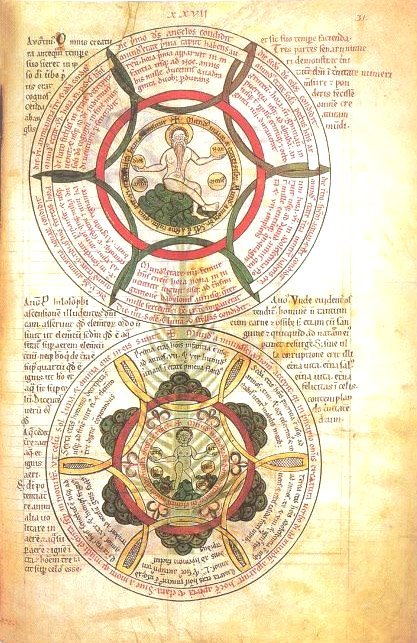
View On WordPress
#1 John 2#1 John 2:18-21#2 Thessalonians 2:1-12#antichrist#man of lawlessness#once saved always saved#permanent salvation#perseverance of the saints#Proof of Salvation
1 note
·
View note
Text
Do not let anyone ·fool [deceive] you in any way. That day of the Lord [v. 2] will not come until the ·turning away from God [great rebellion; apostasy; Matt. 24:11–12; 1 Tim. 4:1; 2 Tim. 3:1–5; 2 Pet. 2:3; Jude 18] happens and the Man of ·Evil [Wickedness; L Lawlessness; C probably the Antichrist; 1 John 2:18; Rev. 13], ·who is on his way to hell [L the son of destruction; John 17:12] , appears. - 2 Thessalonians 2:3 http://www.biblegateway.com/passage/?search=2Thessalonians2:3&version=EXB
0 notes
Photo

#theyoungpope "The day of the Lord will not come unless the apostasy comes first, and the Man of Lawlessness is revealed, the Son of Destruction.. ..who opposes and exalts himself above every so-called god or object of worship, so that he takes his seat in the temple of God, displaying himself as being God." 2Thessalonians2:2-4. http://bit.ly/2nonId5
0 notes
